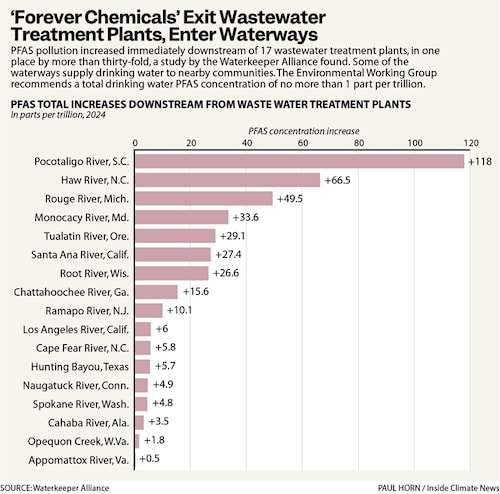Recent research from Waterkeeper Alliance warns that 98% of tested waterways across 19 states contain PFAS, and the problem is particularly noticeable in areas downstream from water treatment plants and sites where biosolids are applied.
According to a new report, the PFAS Report Phase II, 95% of sampling sites that were downstream from wastewater treatment plants and 80% of samples downstream from biosolids sites had higher concentrations of multiple PFAS.
“There is no denying that PFAS contamination is a national crisis. Our latest sampling confirms that it’s widespread and persistent, threatening waterways and public health across the country,” Marc Yaggi, CEO of Waterkeeper Alliance, said in a statement. “Local Waterkeepers and partners bring deep local knowledge and dedication to this ongoing effort, helping to fill critical data gaps, driving policy and solutions.”
PFAS at one site downstream from a water treatment plant increased nearly 3,000% to 228.29 parts per trillion (ppt), according to the report. The PFAS level at one site downstream from a biosolids site increased 5,100%, reaching 106.1 ppt.
Further, the levels of PFAS found in samples from all water treatment plants and 90% of biosolids sites exceeded 1 ppt, a safety limit set by the Environmental Working Group. PFOA and PFOS, which may be linked to higher risks of cancer and birth defects, were also found to exceed the federal thresholds for drinking water in some samples.
The report revealed the most contaminated river as the Pocotaligo River, located in South Carolina. Lack of limits on wastewater discharge contributed to the contamination here, The State reported.

“PFAS can contaminate our water, soil, air, and evidence suggests that it is linked to several diseases and health risks,” said Vanessa Muñoz, waterways program manager at Hispanic Access Foundation. “But what is often overlooked is who is being exposed to it and why, and unfortunately Latino and other communities of color are disproportionately faced to bear the burden.”
The research builds upon a previous report, the PFAS Report Phase I published in 2022, which revealed PFAS contamination in 83% of tested waterways.
Last month, a study detected PFAS in private wells in Pennsylvania, and a previous report from the Environmental Working Group estimated that PFAS contamination from biosolids, or sewage sludge, was impacting as many as 20 million acres of crops in the U.S.
Despite growing research on the widespread contamination of PFAS and links between PFAS and negative health outcomes, the U.S. Environmental Protection Agency (EPA) recently announced considerations for “regulatory flexibility” on PFAS standards.
In response, Waterkeeper Alliance is calling on the EPA to establish and enforce federal standards for PFAS in drinking water and surface water discharges; ban PFAS-contaminated biosolids from being applied on land; regulate PFAS by class than individual compounds; and prioritize and improve monitoring and treatment efforts and funding.
“Currently, there is little accountability for PFAS entering our environment and water through poorly regulated pathways,” Yaggi said. “American communities are exposed daily, often unknowingly, and many face serious, disproportionate health risks. The tools to address this crisis exist, but the political will is lacking. We cannot afford more watered-down regulations and loopholes for industrial source polluters. The science is clear: EPA and lawmakers must act decisively, and with urgency, in the public’s interest.”
The post Higher Levels of PFAS Found in Waterways Downstream From Wastewater Treatment Plants: Report appeared first on EcoWatch.














